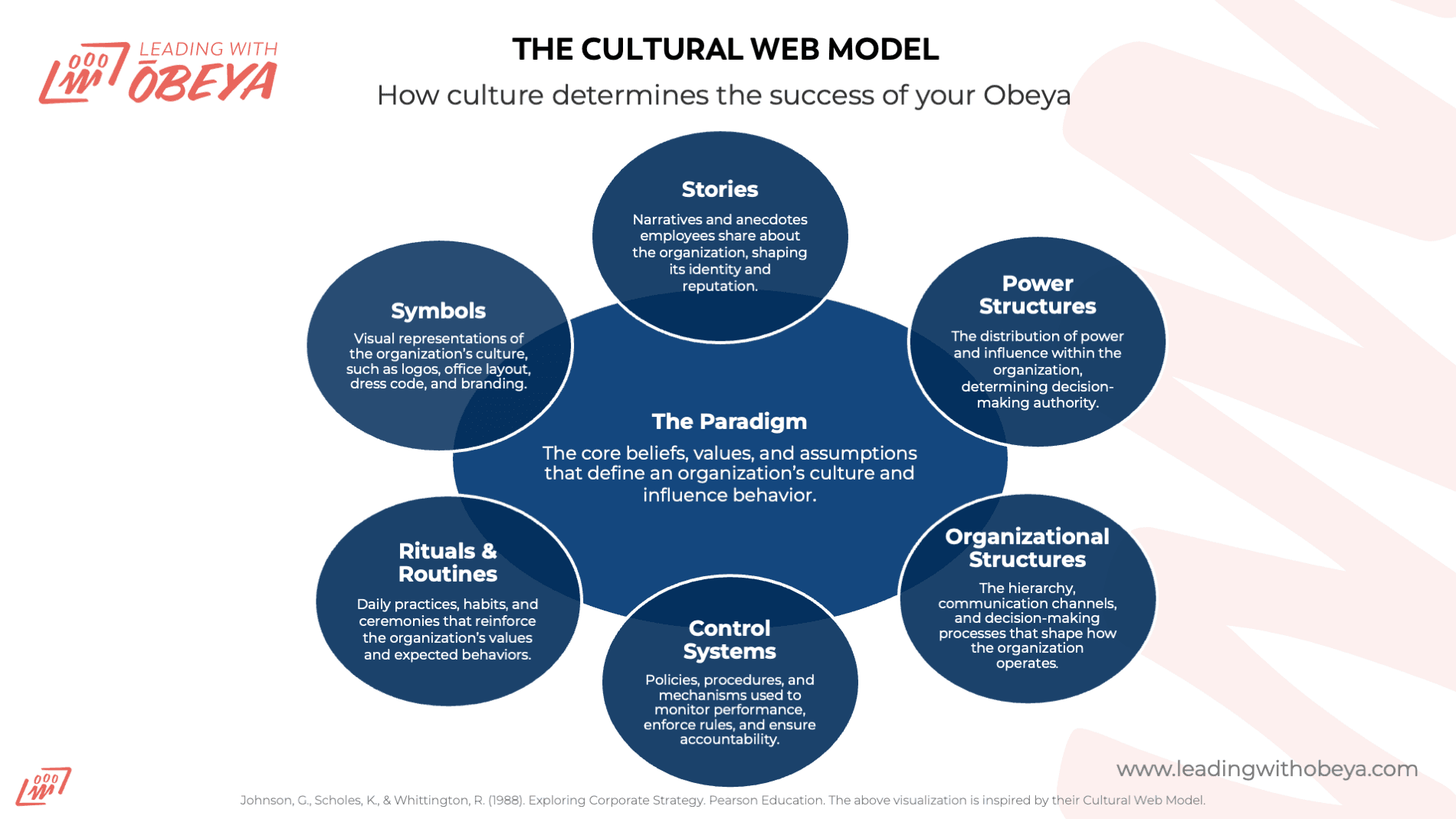
Obeya is a powerful tool for enabling teams to collaborate effectively and achieve goals. But why does it work in some organizations and not in others? The answer lies in organizational culture. The way people collaborate, make decisions, and solve problems determines whether Obeya has a real impact or remains just another management tool.

The Cultural Web Model explains how different cultural elements shape an organization’s ability to implement strategic planning, improve cross-functional collaboration, and drive continuous improvement. This visualization is inspired by the work of Johnson, Scholes, & Whittington (1988) and connects to approaches like Hoshin Kanri, Lean management frameworks, and Obeya for strategic alignment.
The Cultural Web Model provides insight into the cultural factors that either strengthen or hinder Obeya. This model helps not only to analyze the current culture but also to implement targeted improvements that reinforce and embed Obeya within the organization. In this article, you will discover how to align culture and Obeya so that you not only start successfully but also integrate it sustainably into your way of working.
The Cultural Web Model and Obeya
The Cultural Web Model by Johnson and Scholes describes six elements that together shape organizational culture. Each of these elements influences the effectiveness of Obeya. Below, we discuss these six elements and how you can leverage them to make your Obeya successful.
Symbols: what do you see in the organization?
Symbols are visible aspects of an organization, such as branding, office layout, and the language used in communication. These indicate what is considered important within the organization.
Example:
An organization that takes Obeya seriously will have a physical or digital Obeya space that is clearly visible and actively used. In a company with strong visual management, strategic goals and performance indicators are displayed centrally so that everyone can see and understand them. Conversely, if senior management continues to rely mainly on PowerPoint presentations, Obeya is likely to be perceived as just another tool rather than a fundamental shift in collaboration.
Action:
Ensure that Obeya is not just a physical space but also a visible and recognizable part of how the organization operates. This means, for example, incorporating dashboards and visual summaries into management meetings.
Stories: which narratives strengthen or weaken Obeya?
Stories within an organization define how success is achieved, who the heroes are, and which mistakes are unacceptable. These narratives influence how people perceive change and collaboration.
Example:
If the dominant story within the organization is that “real decisions are always made in the boardroom,” then Obeya will struggle to be effective. On the other hand, if stories circulate about how teams have used Obeya to solve problems faster and work more effectively, this strengthens Obeya’s acceptance.
Action:
Actively share success stories about Obeya. Encourage employees and teams to share how Obeya has helped them collaborate better, make better decisions, or solve problems more quickly.
Power structures: who influences decision-making?
Power structures determine who has authority in an organization and how decisions are made. This strongly influences how well Obeya can function.
Example:
In a hierarchical organization where managers are used to making top-down decisions, it will be difficult to create a culture of collaboration and shared ownership within the Obeya. In contrast, when leaders regularly participate in Obeya sessions and encourage teams to make their own decisions, Obeya becomes a reinforcing mechanism.
Action:
Ensure that leadership plays an active role in the Obeya. This does not mean just being present but actively listening, asking questions, and supporting teams in making decisions.
Organizational structures: how do teams work together?
The organizational structure defines both formal and informal ways of working within a company. This impacts how effectively Obeya can be integrated.
Example:
If departments work in silos and there is little cross-functional collaboration, Obeya will struggle to take root. However, in an organization where teams are already accustomed to working in a multidisciplinary way, Obeya will be much easier to implement.
Action:
Make Obeya a part of formal decision-making structures. This could mean linking Obeya sessions to existing meeting rhythms or ensuring that strategic goals in the Obeya align with performance indicators across teams.
Control and measurement systems: what is being monitored?
What an organization measures and how it defines success significantly influences employee behavior. Control and measurement systems determine the effectiveness of Obeya.
Example:
If a company primarily focuses on individual KPIs and short-term results, Obeya may be perceived as inefficient. However, if the organization prioritizes shared objectives and long-term value, Obeya becomes a powerful tool for improving collaboration.
Action:
Ensure that the KPIs and dashboards in the Obeya align with the organization’s strategic goals. Use performance indicators that encourage collaboration and long-term value rather than just individual performance.
Rituals and routines: what does daily work look like?
Rituals and routines are the habitual behaviors and processes that define how employees work. These have a significant impact on how effectively Obeya is used.
Example:
If management decisions are typically made in lengthy meetings without visual support, Obeya will not easily become an integral part of the organizational culture. In contrast, organizations that hold structured, concise Obeya sessions as part of their routine create a strong foundation for its success.
Action:
Introduce fixed rhythms and routines for using Obeya. For example, implement a weekly strategy update within the Obeya and daily stand-ups to discuss key priorities.
Conclusion: culture and Obeya must be aligned
Obeya is not a plug-and-play solution for better collaboration; it is a way of working that must be deeply embedded within the culture of an organization. By applying the Cultural Web Model, you can identify which cultural factors contribute to Obeya’s success and where barriers exist.
If you want to make Obeya truly effective, ensure that:
- Symbols are visible and recognizable throughout the organization.
- Positive stories about Obeya are shared and promoted.
- Power structures are adjusted so that teams feel empowered.
- Organizational structures are aligned with the Obeya approach.
- Measurement systems focus on collaboration and long-term value.
- Rituals and routines support the daily use of Obeya.
By consciously steering these elements, you ensure that Obeya is not only successfully implemented but also becomes a sustainable part of the way the organization operates.
About the author
This article was written by Bertus Groenewegen. He works as a Coach and Trainer at a Recognized Training Partner of Leading with Obeya: Obeya Coaching & Training from the Netherlands. If you want to know more about possible partnerships, read more about it on our Partner page.
Source cited:
- Leading with Obeya, Tim Wiegel
- Johnson & Scholes, Cultural Web Model

